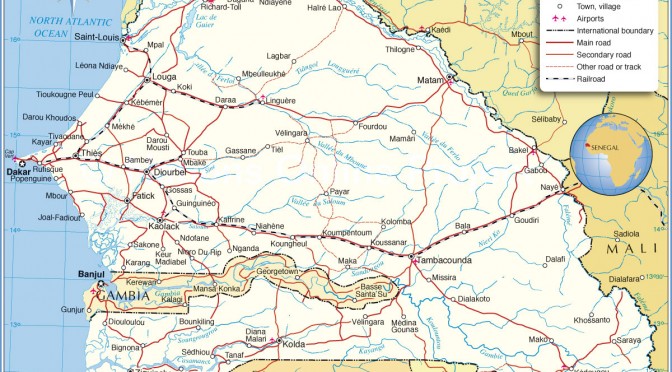In addition to world class energy developments taking place within the oil and gas industry, Senegal is making moves to exploit its significant renewable energy resources, positioning the Mauritania, Senegal, Gambia, Guinea Bissau and Guinea Conakry (MSGBC) region as a globally competitive renewable energy market. Through the country’s Taiba N’diaye wind power project, located 70km north-east of the capital city Dakar, Senegal is stimulating green investment, accelerating regional electrification, and creating a domino effect of renewable energy developments across the wider MSGBC region.
Led by renewable power company Lekela, the Taiba N’diaye project comprises Senegal’s first utility-scale wind power project. The 158MW onshore wind facility covers 41 hectares and is equipped with 46 wind turbines each with a nominal capacity of 3.45MW. The national power utility company, Senelec, signed a power purchase agreement with the wind farm whereby Senelec will purchase power generated by the project for 20 years, distributing critical electricity across the country.
Development of the project is taking place in three stages, with Phase 1 bringing 16 turbines online, Phase 2 installing 16 turbines, and the final stage 14 turbines. With phase one completed in December 2019, the project has already increased access to electricity while reducing CO2 emissions by 300,000 tons. Construction of the wind farm began at the end of 2018 with completion scheduled at the end of 2020. However, with COVID-19 causing unprecedented construction delays – due to economic slowdowns – full-scale commissioning is now expected in 2021 whereby the wind farm will become fully operational.
Having reached financial closure in 2018, the Taiba N’diaye project has successfully attracted over $400 million investment – with the Overseas Private Investment Corporation committing $250 million in financing and $70 million in reinsurance, the Danish Export Credit Agency EKF guaranteeing a $161 million export loan and the Multilateral Investment Guarantee Agency providing political risk insurance. In addition to direct project investment, Taiba N’diaye benefits from strong government and community support, boasting an extensive social investment program targeting $20 million investment in the host community throughout the lifespan of the project. Notwithstanding financial investments, the project will also enable regional human capital development, with training programs and knowledge and skills transfer enhancing regional capacity building. Therefore, the MSGBC region stands to benefits financially, socially, and economically, all from one wind project.
The project’s regional significance extends from attracting foreign investment, to ensuring a viable power generation solution and stimulating regional renewable developments. In terms of power benefits, the project will provide low-cost, renewable energy to Senegal’s national grid, providing a 15% increase in electricity generation capacity for the country and supplying over 2 million people with valuable electricity. With the region’s increasing demand for clean and economically priced electricity – Senegal currently has some of the highest generation costs in sub-Saharan Africa – the project marks an important milestone in the journey to universal access to electricity.
Meanwhile, the project is expected to create a domino effect of new renewable developments, not just in Senegal, but across the entire MSGBC region. As a Power Africa supported project – a U.S. Government led partnership that brings together technical and legal experts, the private sector, and regional governments to accelerate power developments and increase electrification – the Taiba N’diaye project had multiple investment partners, all focused on expanding renewable energy in Africa. With the success of the project behind them, companies such as the OPIC, the U.S.-Africa Clean Energy Financing Facility, and the World Bank’s MIGA are all looking to contribute to the MSGBC region’s renewable development, and regional stakeholders should seize this opportunity.
Accordingly, the MSGBC region’s renewable outlook is incredibly optimistic, with renewed interest in the solar, wind, and hydropower spurring new developments. Senegal, in particular, has emphasized the role renewables will play in the market and has set up ambitious targets to reach universal access to electricity by 2025, achieve 200GWh of hydropower production, and have renewables make up 30% of the power mix by 2025. Additionally, Mauritania hopes to expand its renewable energy sector, capitalizing on its significant solar and wind resources. Finally, with its current total reliance on petroleum for power generation, stakeholders are pushing for an accelerated renewable uptake in the The Gambia. Accordingly, the regional opportunities are endless and the MSGBC region is well positioned to become a global renewable energy leader.
In response to growing demand for renewable power, and increasing interest by international stakeholders to invest, develop, and succeed in Africa, Energy Capital & Power will hold the MSGBC Oil, Gas, & Power 2021 conference and exhibition on the 1-3 December 2021. Focused on enhancing regional partnerships, spurring investment and development in the oil, gas and power sectors, the conference will unite regional international stakeholders with African opportunities, serving as a growth-oriented platform for Africa’s energy sector.
By Charné Hundermark, Southern and East Africa Editor


